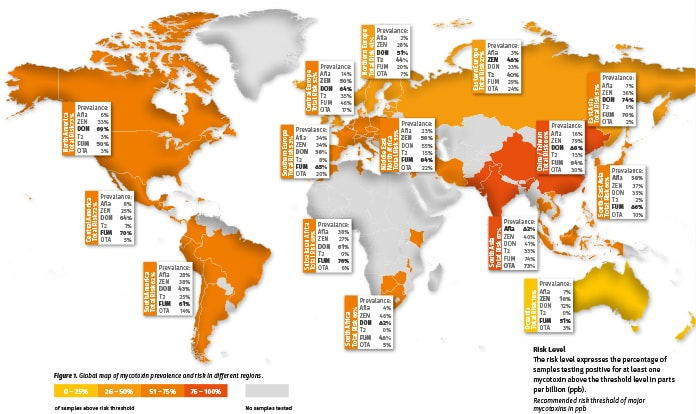Royal DSM has released latest annual DSM Mycotoxin Survey results detailing the occurrence of fungal metabolite contaminants in feed crops and the potential risks to farm animals worldwide.
Health, nutrition and bioscience expert DSM has unveiled its mycotoxin survey results of over 112,000 analyses conducted on more than 24,000 samples of animal feed ingredients collected from 75 countries in 2021.
HAVE CLEAR AND ACCURATE VIEW OF FEED CONTAMINANTS
Anneliese Mueller, Product Manager Mycotoxins, DSM Animal Nutrition and Health says, “Mycotoxins compromise animal health and gut integrity, increasing the probability of lower health status, poor performance and inefficient use of resources. Having a clear and accurate view of feed contaminants enables the industry to take appropriate countermeasures and improve profitability, animal health, welfare and sustainability.”
MYCOTOXIN RISKS HIGH COMPARED TO LAST YEAR
Overall, mycotoxin-related threats to animal protein production remain high compared to last year. Globally, the average risk level was 62%—meaning that nearly two-thirds of samples had at least one mycotoxin above recommended levels. On a regional basis, calculated risk levels ranged from a moderate 44% in whole of Europe to a high of 79% in Asia.
MAIN REGIONAL TRENDS
• North American corn (maize) shows slightly increased concentrations of deoxynivalenol and fumonisins while showing the same high prevalence as in 2020.
• Deoxynivalenol levels are the main potential threat in the European cereal harvest; Western and Southern Europe are the most affected areas. The prevalence of T-2 toxin increased in Northern Europe as did the prevalence of aflatoxins in Southern Europe.
• Asia Pacific faces a heightened risk of mycotoxins overall and aflatoxins remain a problem in this region. An increase in the abundance of Ochratoxin A and T-2 toxin has been observed.
• In Latin America, fumonisins are still the most prevalent mycotoxin in corn. While we observed a slight decrease in concentration levels of fumonisins in South American corn, deoxynivalenol levels increased.

• In Middle East and North Africa Fusarium mycotoxins are highly prevalent. Deoxynivalenol is a main concern in Sub-Saharan Africa.
“ADOPT A ROBUST MYCOTOXIN RISK MANAGEMENT PROGRAM”
“Risk levels conveyed in the findings indicate the likelihood that farmers confront mycotoxin contamination in the feed. Looking at the latest results, it would be wise for producers everywhere to vigilantly monitor raw commodities and feed for mycotoxin contamination, and to adopt a robust mycotoxin risk management program”, states Anneliese Mueller.
